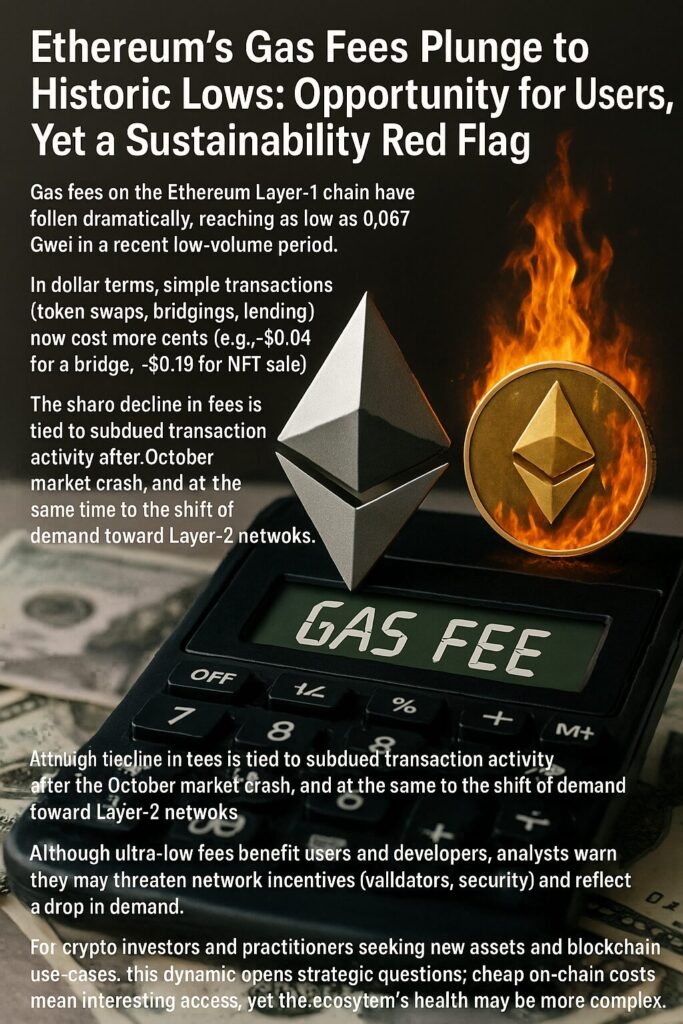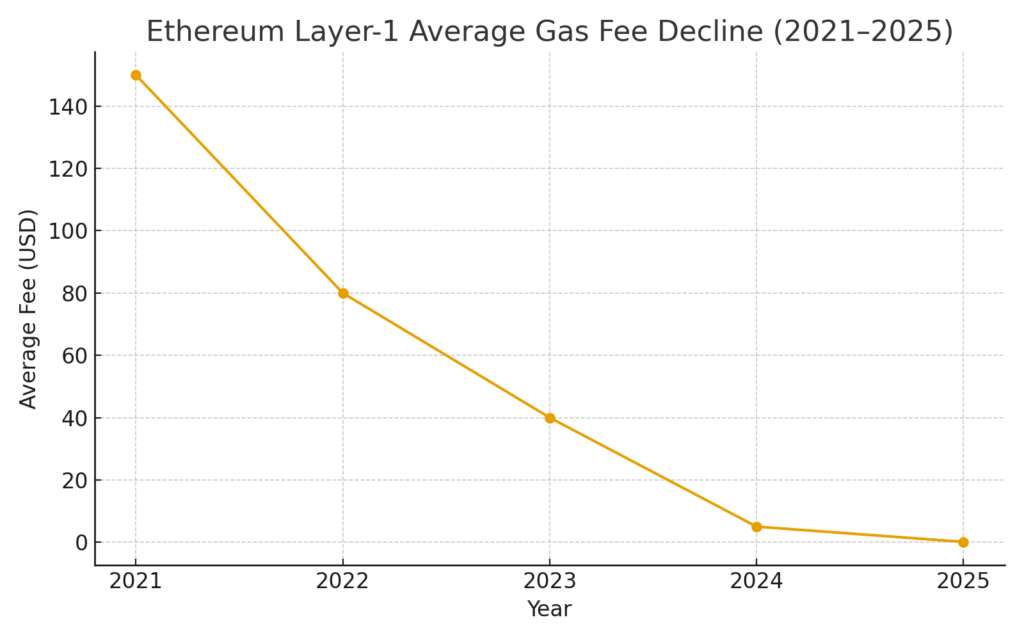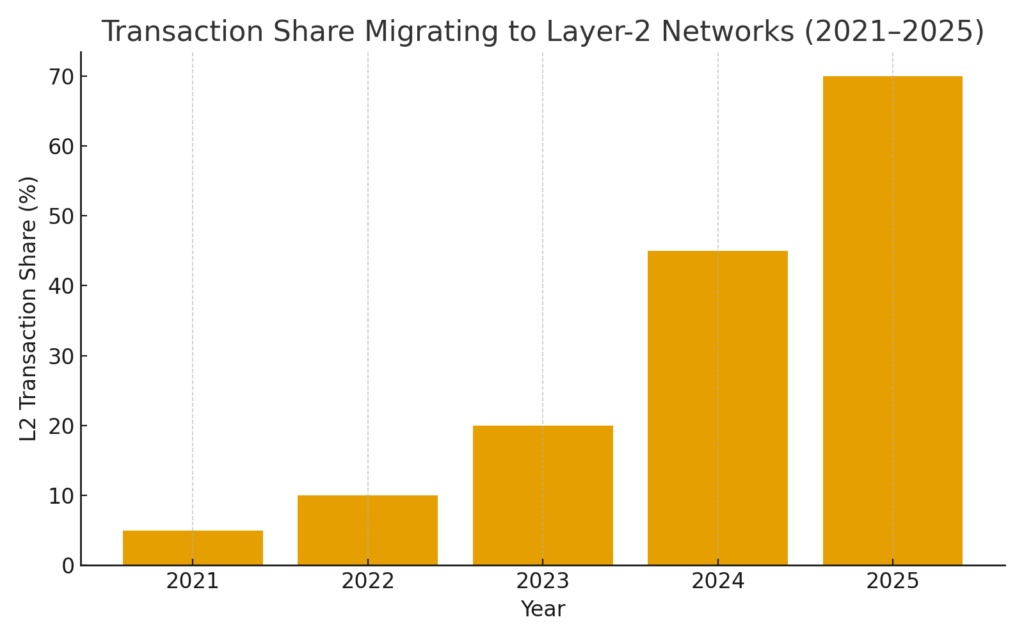
Main Points :
- Gas fees on the Ethereum Layer-1 network have fallen to historic lows (≈0.067 Gwei), translating into transaction costs as low as ~$0.04 to ~$0.19.
- This decline reflects falling on-chain activity on L1, migration of demand to Layer-2 rollups and off-chain solutions, and the impact of the Dencun upgrade that improved scalability.
- While low fees benefit users and developers (especially those exploring new crypto assets and DeFi use-cases), the sharp drop in L1 fee revenue raises concerns about network incentives, validator economics and long-term sustainability.
- For investors and builders looking at new assets or blockchain applications, the environment presents both opportunity (cheap transactions, L2 growth) and risk (underlying ecosystem health, migration risk).
- Strategic takeaway: Focus on where value is migrating (e.g., L2s, data-availability, rollups) rather than only the cheap transaction cost on L1, and assess revenue/incentive models underlying protocols.
1. The Fee Collapse on Ethereum Layer 1

Transaction costs on Ethereum’s Layer 1 blockchain have dropped precipitously. According to data from Etherscan and other aggregators, average swap costs on L1 are now around $0.11, NFT sales cost ~$0.19, bridging to other chains ~$0.04, and on-chain borrowing ~$0.09.
In denomination terms, gas price reached as low as 0.067 Gwei on a Sunday, which is far below the 2021 era highs where fees could spike into the tens or hundreds of dollars.
Historically, during high network congestion in the 2021 bull run, Layer 1 fees on Ethereum exceeded $150 per transaction.
This dramatic reduction is largely driven by decreased L1 load and the scaling of rollups and L2 solutions, which free up L1 capacity and drive down fees.
What this means for users and developers:
- On-chain experimentation becomes far cheaper. Microtransactions, small value DeFi or NFT experiments become more economically viable.
- For builders designing a wallet, dApp, or token project (which you as a developer are interested in), the barrier to L1 usage is much lower—good for user acquisition and UX.
- For users hunting new assets or revenue opportunities, low fees reduce execution friction (for example exploring side-chains, bridges, rollups).
- However—and this is key—the low fees may reflect weaker demand or shifting economic incentives, which must be weighed.
2. The Underlying Cause: Migration to Layer 2 and the Dencun Upgrade

The driver behind the fee collapse is not merely a benign cost reduction but part of a structural shift in Ethereum’s architecture and economics. The Dencun upgrade implemented “blobs” or data-availability improvements (via EIP‑4844) to optimize Layer 2 settlement and reduce cost of posting data to L1.
As a result, Layer 2 networks—such as roll-ups—have seen surging adoption. One source cites “1.6 million daily transactions via L2 scalability” and 46 million monthly transactions.
Concurrently, L1 revenue has collapsed: one report states the mainnet fee income dropped ~99% after the upgrade, due to migration of transaction activity off L1.
Another analysis described Ethereum’s fee revenue in August 2025 at ~$39.2 million—a 75% year-over-year drop from ~$157 million in August 2023—despite ETH hitting new price highs.
Implications of this migration:
- On one side, it is a sign of growth: Ethereum is evolving from single-layer settlement to a roll-up-centric ecosystem, which promotes scalability.
- On the other side, it implies that the base layer (L1) may no longer capture the same value or fee revenue—leading to questions of how the security/incentive model is funded.
- From a practical point of view, developers designing new protocols or applications must consider where user activity is migrating: Is your target L1 or an L2? The economic model matters.
3. The Risk: Ecosystem Incentives and Sustainability
While the ultra-low fees are attractive for users, they raise structural risks. Some analysts warn that a persistently low fee environment on L1 undermines the economics of validators and network security.
If fee revenue becomes negligible, validators may rely almost entirely on staking rewards (which may compress) and insufficient fees may reduce incentive to secure the network robustly.
Additionally, low usage or transaction volume on L1 can signal lower demand, which might reduce burn-rate of ETH (in the context of EIP-1559 fee burn) and potentially affect deflationary dynamics.
For investors or developers, it is crucial to understand that the “cheap transaction cost” is beneficial—but it may come with trade-offs: shifting value capture, lower incentives, and possibly weaker ecosystem resilience.
4. What This Means for Investors, Builders and New Crypto Opportunities
Given your interest in new crypto assets, revenue opportunities and practical blockchain applications, here are how the dynamics map to your vantage point:
For Investors:
- Lower fees reduce friction for token operations, DeFi strategies and micro-transactions. That opens more experimental assets or small-cap projects to explore.
- However, when assessing assets (especially L1-based ones) you should scrutinize underlying economics: Is the protocol capturing value, generating fees, or facing revenue erosion?
- Consider roll-up or data-availability plays: Given the shift to layer-2, protocols that benefit from L2 growth (for example infrastructure, DA layers, roll-up tokens) may offer differentiated opportunities.
For Builders/Developers:
- If designing a wallet or dApp, you now have cost-effective L1 execution—but consider whether building on L1 versus selecting an L2 makes strategic sense for user experience, cost, settlement trade-offs.
- UX advantage: You can market cheaper transactions as a feature—but also highlight benefits beyond cost (speed, settlement guarantee, ecosystem interoperability).
- Revenue model: If you operate a protocol or service, ask how it monetizes: fee-sharing? staking? bridging? As base layer fees decline, look for alternative capture mechanisms.
For Practical Applications:
- Micro-transactions, metaverse, IoT-blockchain use-cases become more viable with 0.1–$0.20 fees.
- But the infrastructure migration means that you might perform your active logic on an L2 while relying on L1 only for settlement or security. That design trade-off matters.
- For token ICOs or presales: The low cost environment helps—but you should ensure that token economics align with where the value accrues (e.g., L2 adoption, bridging activity, staking reward).
5. Recent Developments & Outlook
Recent articles highlight the following updated points:
- According to reports from November 2025, Ethereum’s gas price dropped to ~0.067 Gwei and the corresponding transaction costs as noted above.
- Some commentary frames the drop as a “double-edged sword”: very user-friendly cost but also raising concerns over network revenue collapse and long-term security.
- Academic research has begun looking at “mis-priced incentives” in roll-up settlement and data‐availability mechanisms, which underscores that new architecture brings new risks (e.g., pricing attacks, settlement delays).
- There is also commentary that Ethereum’s pivot to being a global settlement and data-availability layer (for L2s) might be intentional—i.e., the reduced fee capture is not accidental but a design outcome.
Outlook for stakeholders:
- If demand picks up again on L1 (say via a surge in NFT activity, on-chain gaming or DeFi), we might see fee rebound—but the ecosystem likely stays L2-centric, so major fee recovery on L1 is uncertain.
- The value-capture of Ethereum ecosystem will increasingly depend on roll-ups, bridging, data availability, staking and infrastructure rather than base-layer transaction fees.
- For new asset opportunities: Tokens or protocols that capture value in L2 settlement, bridging, roll-up infrastructure or DA (data availability) may offer asymmetric upside relative to pure L1 fee-capture models.
- Developers should monitor validator economics, staking yields, burn-rate of ETH, and how protocol fee revenue evolves—these are signs of ecosystem health beyond just low fees.
Conclusion
The dramatic decline of gas fees on Ethereum’s Layer 1 network presents both a compelling and a cautionary story. For users, builders and investors seeking new crypto assets, cheaper transactions open doors to more experimentation, lower cost infrastructure and greater access. However, the underlying cause of the drop—namely migration of activity to Layer 2, structural shifts in value-capture and diminishing fee revenue—raises important questions about ecosystem sustainability, incentive models and where value will accrue in the next phase of blockchain evolution.
From your perspective of seeking new assets, revenue streams and implementing practical blockchain applications: this environment is promising—but it demands a deeper lens. Ask not only “How cheap are transactions?” but “Where is the value being captured? Which layer is growing? Where are the incentives strong?” If your strategies align with these answers—whether they focus on L2 orchestration, token utility, bridging, staking yields or data-availability—the current low-fee era can serve as a launchpad for innovation. Conversely, relying solely on base-layer transaction economics may underperform in the emerging architecture of stack-centric blockchain systems.

